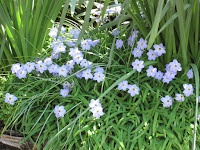Thought I’d use this final post of November 2010 to recap the month’s posts, add in stuff I forgot, clear up ambiguities, update on-going projects, and such like.
NO-DIG BULB PLANTING
I’ve gotten a few questions about the no-dig bulb planting method outlined on the 16th. Tim and I had occasion to plant 400 of the 2200 daffodils Brent and Becky sent us after the post ran. Since pictures are worth thousands of words, I whipped out the trusty digital and documented the process. (Remember, you can click on the pictures to make them bigger, then hit the “back” arrow to return to the text.)
 |
| Photo # 1 |
Photo #1: Pull back the mulch, and run a hard-rake over the cleared area to ruffle the surface. Toss the bulbs into the cleared space. Notice that there are several different cultivars here, a good way to extend bloom season. If you like the naturalized look, move ahead to Photo #3. (You don’t have to worry about the bulbs lying on their sides. One of nature’s many wonders is that they’ll pull themselves upright by the roots. This is particularly soothing knowledge if you’re planting corms: it’s hard to tell if those wrinkly little buttons are right-side-up or not.) If you have anal tendencies, as I do, check out Photo #2.
 |
| Photo # 2 |
Photo #2: Arrange the bulbs so they’re not so messy and random-looking, and are, in fact, upright. For the best flowering display, keep them close together. I usually try for no more than three to four inches. In this picture you can see the raked-back pine straw, helping you gauge the size of this bed, which holds about 175 bulbs.
Photo #3: Mix three-and-a half to four pounds of bulb food (NOT bonemeal) to a 50-pound bag of Black Kow (or whatever) and distribute over the bulbs, following up with soil conditioner (a finely ground pine-bark product). On average, it takes two 50-pound bags of Kow and four or five bags of conditioner to cover about 200 bulbs. (That’ll set you back $18 to $20, but what’s your time worth?) Replace the mulch and, Bob’s your uncle, you’re done without ever touching a trowel.
CONTAINER FERTILIZER RECIPE
Make your own no-burn container fertilizer by combining six 16-ounce cupfuls of Espoma Holly-Tone or Plant-Tone with one 16-ounce cupful of kelp meal. Apply generous amounts at planting and again in January or February. (What’s “generous”? I generally use one batch per each 32-quart bag of potting soil. How much you use to topdress in late winter depends on the size of the container.) Remember—the nutrients in the Osmocote beads can’t be released unless the soil temperature is 70°F or higher. Save the time-release stuff for summer.
I’ll add a link to Espoma’s website on the right. If you live in my area, their mostly natural products are available at Farmers Supply near the bottom of Oleander Drive in Wilmington.
VEGETABLE SURPRISE
 |
| Late harvest |
The day before Thanksgiving, I moseyed out to my disappointing vegetable garden with the aim of yanking everything out of it, when what to my wondering eyes did appear but the first red tomato to come out of the miserable patch since early July. There were also a pair of bell peppers and a trio of ‘Cosmic Purple’ carrots from the crop I’d sown back in August.
Gardening is like that. Just when you think you know everything, you learn you’re not even in the ball park. The tired, tattered vines held another 20 or so green tomatoes, so I left them alone. If frost continues holding off, we may actually get one or two more vine-ripened fruit. How about that?
 |
| Late lettuces |
Anybody know a good way to ripen green tomatoes? My kitchen’s windowsill space is severely limited. I tried the cardboard-box-in-a-cool-dark-place last winter: didn’t work that well. I still had little green tomatoes in March. Maybe under the clothesbasket under the bed wasn’t dark or cool enough.
HOUSEPLANT UPDATE
Well, nothing’s died yet. The papayas immediately dropped all their mature leaves, but the new ones keep coming. We’re sweeping up a dustpan-full of variegated Solanum foliage every day too, but as is usual with many- and small-leaved specimens, the loss isn’t too noticeable. Yet.
The cats chewed the Ledebouria and the Hemigraphis, so I swathed them in bird-netting. The Cordyline, a veteran of the kitchen, soldiers stoically on, as does the dracaena. The mango is sulking, but what else would you expect from a mango? The mystery plant seems unfazed, if thirsty… so far.
The original nine have been joined by the dahlia off the front porch, and a gift from my friend, Christine (the source of the papayas)—the majorly cool-looking tapeworm fern. Its formal, patented name is ribbon plant, but how boring is that for a plant whose flattened stems actually resemble green tapeworms? The cats have expressed interest in chewing on the tapeworm, too, but I’m trying tough love, rustling the dreaded plastic bag whenever necessary.
My friend Ted gave me a bottle of SuperThrive. I’ve seen its comic-book-like adverts in American Nurseryman for years, but was skeptical. It claims to be—and I quote—“#1 ACTIVATOR, #1 REVIVER, #1 TRANSPLANTER, #1 EXTRA GROWER, #1 PERFECTER.” Ted says it’s worth a try, so I shall. Hey, plants in my house need all the help they can get.
Thanks for dropping by. Can you believe it’s almost December already?
Kathy
























